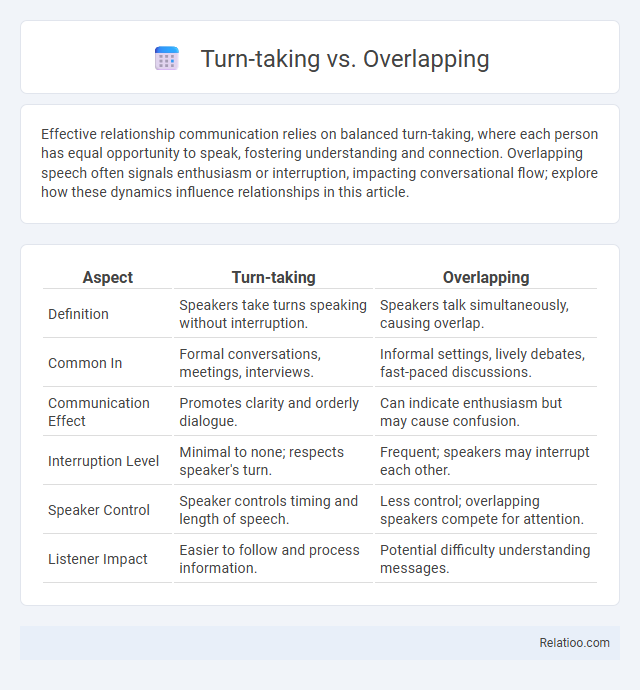Effective relationship communication relies on balanced turn-taking, where each person has equal opportunity to speak, fostering understanding and connection. Overlapping speech often signals enthusiasm or interruption, impacting conversational flow; explore how these dynamics influence relationships in this article.
Table of Comparison
| Aspect | Turn-taking | Overlapping |
|---|---|---|
| Definition | Speakers take turns speaking without interruption. | Speakers talk simultaneously, causing overlap. |
| Common In | Formal conversations, meetings, interviews. | Informal settings, lively debates, fast-paced discussions. |
| Communication Effect | Promotes clarity and orderly dialogue. | Can indicate enthusiasm but may cause confusion. |
| Interruption Level | Minimal to none; respects speaker's turn. | Frequent; speakers may interrupt each other. |
| Speaker Control | Speaker controls timing and length of speech. | Less control; overlapping speakers compete for attention. |
| Listener Impact | Easier to follow and process information. | Potential difficulty understanding messages. |
Introduction to Turn-Taking and Overlapping
Turn-taking is a fundamental mechanism in conversation that regulates the orderly exchange of speaking turns between participants, ensuring smooth communication flow. Overlapping occurs when two or more speakers talk simultaneously, which can indicate agreement, interruption, or transitional moments in dialogue. Understanding the dynamics between turn-taking and overlapping is essential for analyzing interaction patterns in conversational studies and improving communication effectiveness.
Definition of Turn-Taking in Communication
Turn-taking in communication refers to the structured exchange of speaking roles between participants, ensuring smooth interaction by allowing one person to speak at a time. Overlapping occurs when speakers talk simultaneously, which can lead to interruptions or miscommunication. Understanding turn-taking helps you maintain clarity and respect in conversations, promoting effective and cooperative dialogue.
Understanding Overlapping in Conversation
Understanding overlapping in conversation reveals moments when speakers talk simultaneously, which can indicate enthusiasm, agreement, or a struggle for the floor. Unlike turn-taking, where speakers alternate smoothly without interruption, overlapping can both enrich and disrupt communication depending on context and social cues. Your ability to recognize and navigate overlapping enhances conversational flow and prevents misunderstandings.
Key Differences Between Turn-Taking and Overlapping
Turn-taking involves speakers alternating their turns in conversation, allowing each person to speak without interruption, whereas overlapping occurs when two or more people speak simultaneously, often leading to confusion or miscommunication. The key differences between turn-taking and overlapping lie in conversational flow and clarity; turn-taking promotes orderly communication and mutual understanding, while overlapping can disrupt the exchange and hinder message comprehension. You can improve your communication skills by recognizing these dynamics and managing your speaking turns to minimize overlaps.
The Role of Turn-Taking in Effective Communication
Effective communication relies heavily on smooth turn-taking, where speakers alternate speaking roles to ensure clarity and mutual understanding. Overlapping speech often leads to confusion, interruptions, and misinterpretations, hindering the exchange of ideas. Your ability to manage turn-taking enhances dialogue flow, minimizes conflicts, and fosters more meaningful interactions.
Causes and Functions of Overlapping Speech
Overlapping speech often occurs due to factors such as eagerness to contribute, interruptions, or misaligned turn cues, signaling active engagement or disagreement. This phenomenon functions to regulate interaction flow, assert dominance, or display enthusiasm within a conversation. Understanding causes and functions of overlapping is essential for analyzing conversational dynamics and managing effective communication.
Cultural Variations in Turn-Taking and Overlapping
Cultural variations significantly impact turn-taking and overlapping patterns in conversations, with some cultures viewing overlapping speech as a sign of engagement and others as interruptive. For example, Mediterranean and Latin American cultures often accept overlapping as normal participation, whereas East Asian cultures typically emphasize strict turn-taking to maintain harmony. Understanding these cultural nuances is crucial for effective cross-cultural communication and minimizing misunderstandings in conversational dynamics.
Impacts on Communication Flow and Clarity
Turn-taking ensures orderly communication flow by allowing each participant to speak without interruption, enhancing clarity and understanding. Overlapping often disrupts the conversation, causing confusion and reducing the effectiveness of message transmission. Balancing turn-taking and controlled overlapping can optimize interaction dynamics, fostering both engagement and clear information exchange.
Managing and Navigating Overlapping in Dialogue
Managing and navigating overlapping in dialogue requires precise turn-taking strategies to ensure clear communication and avoid confusion. Overlapping speech, when multiple participants speak simultaneously, can signal engagement but risks disrupting the flow if not skillfully managed. Your ability to read conversational cues and employ polite interruptions or pauses helps maintain balance between turn-taking and overlapping, fostering productive and coherent exchanges.
Practical Tips for Improving Conversational Turn-Taking
Effective conversational turn-taking enhances communication clarity and mutual understanding by minimizing interruptions and allowing speakers to express their thoughts fully. Practical tips for improving turn-taking include actively listening for verbal and non-verbal cues, such as pauses or intonation shifts, to identify appropriate moments to speak. Encouraging equal participation through open-ended questions and avoiding talking over others fosters a balanced dialogue and reduces overlapping speech, leading to more productive conversations.

Infographic: Turn-taking vs Overlapping
 relatioo.com
relatioo.com